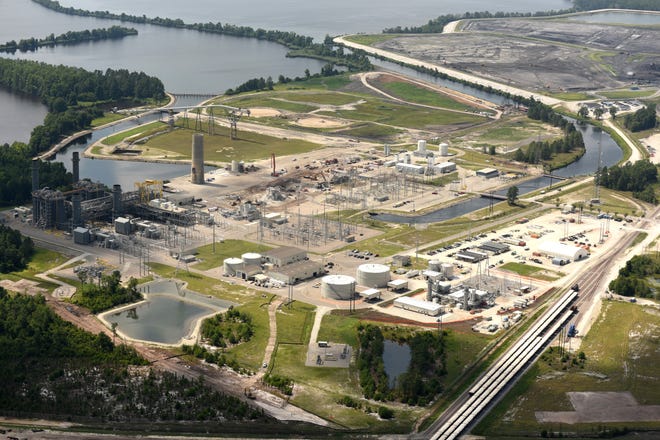New NC carbon plan includes more wind and solar, but delays 70% emission reduction goal
November 14, 2024

Regulators have approved a new version of North Carolina’s future energy plan that lays out how the state will meet its goals, enshrined in law, of being carbon neutral in its energy sector by 2050.
But the order, issued by the N.C. Utilities Commission (NCUC) earlier this month, has frustrated clean energy advocates and environmentalists by allowing Duke Energy, by far the state’s largest utility, to construct more fossil fuel-powered plants and miss a deadline to reduce carbon emissions by 70% by 2030.
“While the order does call for important new utility-scale solar, batteries and wind resources – by allowing Duke to delay coal retirement and build four new methane gas plants the NCUC missed a pivotal opportunity to move away from a fossil fuel centered energy system to a resilient and distributed clean energy future that prioritizes people over profits,” said Jake Duncan, the Southeast regulatory director at Vote Solar, in a release.
Duke, however, says the order offers a realistic pathway to meeting the state’s carbon-free goal that doesn’t break the bank for consumers and allows the company to keep the lights on even as it ramps up the amount of renewable energy sources, like wind and solar, in its energy portfolio.
“We believe this is a constructive outcome that allows us to deploy increasingly clean energy resources at a pace that protects affordability and reliability for our customers,” the company said after the Nov. 1 order was released. “The order confirms the importance of a diverse, ‘all of the above’ approach that is essential for long-term resource planning and helps us meet the energy needs of our region’s growing economy.”
Under legislation approved by Democratic Gov. Roy Cooper and the GOP-controlled N.C. General Assembly in 2021, the utilities commission has to take “all reasonable steps” to achieve 70% carbon emission reductions from 2005 levels by 2030 and reach carbon neutrality by 2050 using a least-cost approach.
POWER PLAY:NC faces challenge of creating a clean, reliable and affordable energy future
‘Can’t afford the new climate pollution’
While the new version of the Carolinas Resource Plan does increase the amount of wind, solar and battery storage Duke has to incorporate into its power grid, it also allows the energy giant to build additional natural gas-fired plants and delay the retirement or retrofitting of two old coal-fired power plants.
Noting that many other companies are moving away from fossil fuels, clean energy advocates said the order falls short in key areas that are crucial for both the environment in a world being battered by climate change and the well-being of all North Carolinians.
Critically to many, the order also allows Duke to delay meeting the 70% carbon reduction goal of 2030 by waving the requirement that the company file at least one portfolio to meet that target.
“This outcome will leave our communities holding the bill for more expensive, polluting power plants and underinvest in the clean, reliable resources that must form the backbone of our grid,” said David Neal, senior attorney with the Southern Environmental Law Center, in a release.
Duke has said projected future power demands have increased significantly in recent years, prompting the company to look at ways to maintain an adequate and reliable power generation capacity even when the sun isn’t shining or the wind isn’t blowing.
Company spokesman Bill Norton said the updated plan also is a fiscally responsible one for ratepayers, with the commission noting in its order that the cost of implementing the plan by 2038, minus inflation, equates to a 1% increase each year for customers.
But environmentalists said the cost of wind, solar and battery storage is dropping every year, and the company’s plan to underinvest in carbon-free renewable power sources and instead in expensive traditional power plants is more to protect its profits than to meet necessary and legally mandated clean energy goals.

More offshore wind, but will it survive Trump?
The decision by the commission comes as clean energy advocates prepare for President Donald Trump to take office in January and his administration’s expected push to walk back some of the green and pro-environment initiatives adopted by President Joe Biden in recent years.
The list of potential targets includes offshore wind, which Trump has repeatedly expressed concerns about due to its high upfront costs and potential impacts to fisheries, shorebirds and marine mammals − although wind advocates say it’s really because the continued growth of offshore wind could harm Trump’s backers in the fossil fuel industry.
PAPER TRAIL:Why development of Brunswick County’s offshore wind farms has largely moved onshore
Duke’s updated carbon plan calls for including up to 2,400 megawatts (MW) of offshore wind in its energy portfolio by 2035, with two of North Carolina’s major wind projects planned for the waters just south of Brunswick County. Initial development and evaluation of the projects, including potential impacts to marine life like the high endangered North Atlantic right whale, is currently underway.
While the recently updated carbon plan has left clean energy advocates grumbling, they won’t have to wait too long to get another chance to tweak it.
State law requires the utilities commission to review and adjust the plan every two years, ostensibly to allow the state to take advantage of the latest and most cost-effective technologies and reflect changes in the energy market. That means Duke will file a new proposal with the commission by September 2025, with an updated plan in place by the end of 2026.
Reporter Gareth McGrath can be reached at GMcGrath@Gannett.com or @GarethMcGrathSN on X/Twitter. This story was produced with financial support from the Green South Foundation and the Prentice Foundation. The USA TODAY Network maintains full editorial control of the work.
Search
RECENT PRESS RELEASES
Related Post



